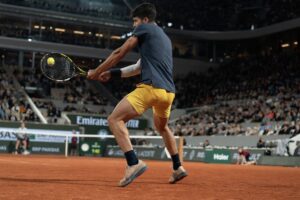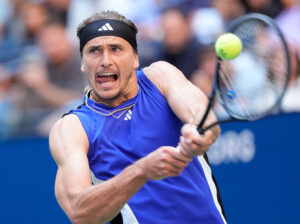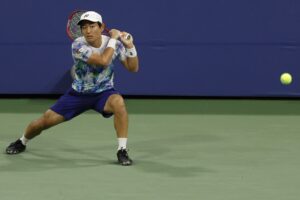Countdown to the US Open: In the third part of our series building up to the US Open, Last Word on Tennis looks back at the greatest US Open Women’s Champions.
Women may have begun competing in the US Open six years after the men (in 1887 as opposed to 1881), but ever since, their contribution to the tournament and to tennis in general has been almost incalculable. Great champions such as Billie Jean King, Martina Navratilova, and Maria Bueno did much to popularize and equalize tennis, with the US Open becoming the first Grand Slam tournament to pay equal prize money to men and women in 1973, largely because of King’s campaigning. And yet those three great champions, who each dominated the US Open for a considerable period of time, do not even make this list.
Here, then, are the five finest US Open Women’s Champions.
#4 (tie): Steffi Graf (Winner of five US Opens: 1988, 1989, 1993, 1995, and 1996)
Unlikely as it seemed when it was first announced, there was something fitting about the fact that Steffi Graf ended up marrying Andre Agassi. Although they were very different personalities on court, with Graf’s cool German self-control contrasting with Agassi’s colourful and even brash behaviour, they were both great champions, with 30 Grand Slam singles wins between them (although Andre is always the first to admit that his wife won the bulk of that total, with 22 Major victories).
They also both excelled at the US Open. Agassi won it twice (in 1994 and 1999), while Graf won it five times, including in 1988, the year of her “Golden Slam”, when she not only won all four Majors in the calendar year but for good measure added the Olympic Gold for women’s singles in Seoul. She was also runner-up at the US Open three times (in 1987, 1990 and 1994). In more than a decade of competition in New York, she went from beating (and occasionally losing to) Martina Navratilova and Gabriela Sabatini to beating (and occasionally losing to) Monica Seles and Arantxa Sánchez Vicario.
Probably her finest win in a US Open final was her 1989 triumph over Navratilova, which confirmed that she had replaced Navratilova at the top of the women’s game, but the greatest final she was involved in was probably her 1994 loss to Sánchez Vicario, when the Spaniard fought back from being blown away in the first set (which she lost 6-1) to win in three sets. Nevertheless, even after that rare defeat to the Spaniard in a Grand Slam final, Graf recovered sufficiently to win the next two US Opens.
Embed from Getty Images
Both her 1995 and 1996 wins were achieved against Monica Seles. The only shame about those victories was that Seles, who had returned to the tour after being stabbed by a Graf fanatic in Hamburg in 1993, was never quite her old dominant self after that dreadful attack. As a result, the women’s game was robbed of what might have been the greatest ever rivalry between two players, one that could even have exceeded Navratilova-Evert. Regardless of that, Graf remains one of the greatest women’s US Open champions and one of the finest women tennis players full-stop.
#4 (tie) Margaret Court (Winner of five US Opens: 1962, 1965, 1969, 1970 and 1973)
There has been a lot of Margaret Court-bashing recently and some of it is entirely justified. Her controversial (to put it mildly) comments about homosexuality in general and gay marriage in particular have attracted a lot of ire from both fans and players, with Martina Navratilova weighing in earlier this year with the charge that Court was racist as well as homophobic, following the apparently approving comments that she had made in the past about South Africa’s apartheid regime. Given all of this controversy, it is entirely reasonable to speculate whether the stadium named in Court’s honor in Melbourne should be renamed. However, what cannot be seriously called into question is her greatness as a tennis player. For more than a decade (from the early 1960s to the early 1970s), she was the greatest woman tennis player in the world, winning not only in her native Australia (she won the Australian title a remarkable 11 times) but at the other three Grand Slam tournaments.
Her record in New York was particularly impressive. She first won the US title in 1962, denying the reigning champion, Darlene Hard of the US, a hat-trick of titles, and although she lost the following year’s final to Brazil’s Maria Bueno she went on to win the tournament four more times in total. Among her most notable wins were her 1965 defeat of Billie Jean King in straight sets and her final victory in 1973 against her fellow Australian, Yvonne Goolagong Cawley, who, incredibly, lost four US finals in a row and, like Bjorn Borg, would never win in New York despite winning multiple Majors elsewhere.
Embed from Getty Images
If Serena Williams had not become pregnant earlier this year, she might already have overtaken Court’s all-time Grand Slam singles record of 24. She might still do so if, as she plans to, she returns to the game after giving birth. However, even if she does ultimately power past Court, the fact that so many other great champions, from Bueno and Billie Jean King to Graf and Navratilova, failed to do so is a testament to the enduring greatness of her tennis. That greatness will endure forever, even if the court named after her is renamed and her offensive and ignorant views rightly rebuked.
#2 (tie): Chris Evert (Winner of six US Opens: 1975, 1976, 1977, 1978, 1980 and 1982)
For most of the 1970s and early 1980s, Chris Evert virtually owned the US Open title. The All-American girl won the All-American title four times in a row between 1975 and 1978 and then, after serious competition had emerged in the form of an even younger American girl (Tracey Austin, who twice won the tournament in 1979 and 1981) she still won two more titles in 1980 and 1982. Martina Navratilova may have held sway on the grass of Wimbledon, but for most of her career Evert was the dominant force on US hardcourt.
Evert emerged after the twin titans of the women’s game in the late 1960s and early 1970s – Margaret Court and Billie Jean King – finally began to falter. Having already won both the French Open and Wimbledon, her first two US Open titles were achieved at the expense of Yvonne Goolagong Cawley, with their 1975 final, which went to three sets, easily eclipsing their 1976 meeting, which Evert won in straight sets, including a six-love second set. She beat another Australian, Wendy Turnbull, in the final in 1977, before beating Pam Shriver in 1978, which was the only Grand Slam singles final that Shriver, Martina Navratilova’s regular doubles partner, ever reached.
Then came the really serious competition, in the form of Tracey Austin, the pig-tailed prodigy who stunned the tennis world by beating Evert in 1979, when Evert was going for a fifth US Open in a row and Austin was only 16 and in her first year as a professional. Evert recovered from that astonishing loss to regain the title in 1980 and she won it for a final time in 1982, in both those finals beating another youthful prodigy, Czechoslovakia’s Hana Mandlíková.
If Austin had been an irritant in denying Evert a fifth successive US Open, Martina Navratilova subsequently proved an immovable obstacle, defeating her in both the 1983 and 1984 finals. Evert would never reach another US Open final again, but with subsequent Grand Slam wins at both the Australian Open (in 1984) and the French Open (1985 and 1986) she finished her career level with her great rival, Navratilova, on 18 Major victories apiece. The fact that the US Open contributed a third of those titles is proof both of how much she loved playing in New York and how much the New York crowds loved her.
Embed from Getty Images
#2 (tie): Serena Williams (winner of six US Opens: 1999, 2002, 2008, 2012, 2013, and 2014)
Serena Williams may yet top this list of the all-time greatest US Open women’s champions, if she returns after giving birth to anything like the form that has made her by far the greatest female player of the last ten years and arguably the greatest of all time. For now, though, she must be content to share second place with Chris Evert.
So much of Serena’s story can be told by focusing on her achievements at the US Open. New York was where she won her first Grand Slam title, in 1999, defeating Martina Hingis in the final after Hingis had beaten Serena’s sister, Venus, in the semi-final. It was a devastating defeat for Hingis, precisely because it proved the difficulty of beating two Williams sisters in the same tournament. The realisation that that was probably too much for her, allied to her increasing injury problems, contributed to her first retirement from tennis in 2003, when she was still only 22.
Serena went on to win five more US Opens, including a hat-trick of titles between 2012 and 2014. She would have made it four in a row in 2015 and achieved a calendar Grand Slam to boot (to go alongside her “Serena Slams” of 2002-03 and 2014-15, when she held all four Major titles at the same time) if she had not lost in the semi-final to Italy’s Roberta Vinci, in what is probably the all-time greatest upset in the history of tennis (not just women’s tennis but all tennis). That defeat, when nerves seemed to get the better of her when the ultimate prize in tennis was almost within her grasp, is a reminder of just how difficult it is to win the calendar Grand Slam – i.e. a real Grand Slam.
What is perhaps most remarkable about Serena is not how many Majors she has won but how few. For much of her twenties, she was not the utterly dominant player that she became in her thirties, as shown by the fact that she went six years between winning her second and third US Open titles (which she won in 2002 and 2008 respectively). In part this may have been because she was still in the shadow of her older sister, Venus, and it is arguable that it was only when Venus developed her debilitating Sjogren’s Syndrome (an auto-immune deficiency) at the end of the noughties that Serena really came into her own, as if she was taking on the mantle of being both Williams sisters in the absence of her sister from Grand Slam finals. Whether this or other factors were what led to Serena’s resurgence, since the end of the last decade she won many more Majors, including many more US Opens, and proved that she is probably the greatest woman player of all time.
#1: Helen Wills Moody (winner of seven US Opens: 1923, 1924, 1925, 1927, 1928, 1929 and 1931)
Before anointing her as the all-time greatest US women’s champion, it must be acknowledged that Helen Wills Moody did not win the most US titles of any woman. That honour goes to Anna Margrethe “Molla” Bjurstedt Mallory, who won even more US titles – eight in total – than she had names. Nevertheless, half of Mallory’s titles were won before the end of World War One, when tennis, particularly women’s tennis, was not the truly global sport that it would become in the 1920s, with the emergence of first Suzanne Lenglen and then Helen Wills Moody. And in her final appearance at the tournament in 1929 (which admittedly came when she was aged 45), Mallory was “double-bagelled” – 6-0, 6-0 – in the semi-final by Wills Moody.
Having thus acknowledged the achievements of Bjurstedt Mallory, it is also right to praise Wills Moody as her superior. Wills Moody’s life spanned almost the entire length of the twentieth century, which has often been dubbed “the American century”, because of America’s emergence as a superpower, and she was undoubtedly one of the greatest American sportsmen or women, and arguably one of the most influential Americans in any field. That was because, unlike Bjurstedt Mallory, whose achievements were largely overshadowed by World War One, Wills Moody had impeccable timing, both on and off the court. On the court, she brought a new speed and grace to the game. Off the court, she emerged after the ravages of World War One, not only as a brilliant new tennis player but almost as the poster girl for the worldwide liberation of women (or at least the liberation of women in the Western world) that was the inevitable consequence of women working in World War One to sustain Western economies while men fought and were killed on a Biblical scale.

Wills Moody (or Wills, as she was before her marriage in 1929 to Frederick Moody) first won the US Open in 1923, defeating Mallory in the final. It was the first of her first hat-trick of titles, achieved between 1923 and 1925, which she followed up with a second hat-trick between 1927 and 1929. (The intervening title, in 1926, was won by Mallory.) Finally, she achieved her magnificent seventh US title in 1931, when she beat Britain’s Eileen Bennett Whittingstall in straight sets in the final.
However, mere statistics do not convey the truth about Wills Moody as a tennis player, any more than they do any tennis player. She was a complete player at a time when most tennis players, especially women players, possessed at least one obvious deficiency (be it backhand, forehand, serve or whatever). By contrast, Wills Moody was said by at least one male contemporary, George Lott, who was himself a multiple Major winner in men’s doubles, to have “no weaknesses whatsoever.” And in addition, she displayed a truly athletic, even gymnastic, grace on the court, which was so intrinsically beautiful that Charlie Chaplin, the great film-maker and ardent tennis fan, once declared that the most beautiful thing he had ever seen was “the movement of Helen Wills playing tennis.” That, more than any simple statistical achievement, should be her lasting legacy.
Enjoy articles looking back at all-time best players and tennis history in general? Make sure to check out our page devoted to stories appreciating historic achievements in tennis.
Main Photo:
Embed from Getty Images






